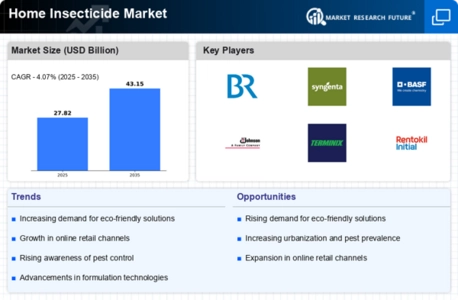Increasing Urbanization
The trend of increasing urbanization appears to be a significant driver for the Home Insecticide Market. As more individuals and families move to urban areas, the demand for effective pest control solutions rises. Urban environments often provide ideal conditions for pests, leading to heightened concerns about infestations. According to recent data, urban households are more likely to invest in home insecticides to maintain a pest-free living space. This shift in population dynamics suggests that the Home Insecticide Market may experience substantial growth as urban dwellers prioritize hygiene and comfort in their homes.
Seasonal Pest Infestations
Seasonal pest infestations are a recurring phenomenon that significantly impacts the Home Insecticide Market. Certain times of the year, particularly spring and summer, see a spike in pest activity, prompting consumers to stock up on insecticides. Data indicates that sales of home insecticides tend to peak during these seasons, as households prepare to combat common pests such as ants, mosquitoes, and flies. This seasonal demand creates opportunities for manufacturers to promote their products effectively during peak times. Consequently, the Home Insecticide Market may experience fluctuations in sales, driven by the cyclical nature of pest infestations.
Rising Awareness of Health Risks
There is a growing awareness of the health risks associated with pest infestations, which serves as a crucial driver for the Home Insecticide Market. Pests such as rodents and insects can transmit diseases, prompting consumers to seek effective insecticides. Recent studies indicate that households are increasingly concerned about the potential health implications of pests, leading to a surge in demand for home insecticides. This heightened awareness may drive innovation in product formulations, as manufacturers strive to create safer and more effective solutions. Consequently, the Home Insecticide Market is likely to expand as consumers prioritize health and safety in their pest control choices.
Expansion of E-commerce Platforms
The expansion of e-commerce platforms is transforming the way consumers purchase home insecticides, thereby influencing the Home Insecticide Market. With the rise of online shopping, consumers have greater access to a variety of pest control products, often at competitive prices. Data suggests that online sales of home insecticides have increased significantly, as consumers appreciate the convenience and discretion of purchasing these products online. This trend may encourage manufacturers to enhance their online presence and marketing strategies, further driving growth in the Home Insecticide Market. As e-commerce continues to evolve, it could reshape consumer purchasing behaviors in this sector.
Innovations in Product Formulations
Innovations in product formulations are playing a pivotal role in shaping the Home Insecticide Market. Manufacturers are increasingly focusing on developing advanced formulations that are not only effective but also environmentally friendly. Recent advancements include the use of natural ingredients and targeted delivery systems that minimize environmental impact while maximizing efficacy. This trend towards innovation may attract environmentally conscious consumers, thereby expanding the market base. As the demand for sustainable pest control solutions grows, the Home Insecticide Market is likely to witness a shift towards more innovative and responsible product offerings.



.webp)
.webp)
.webp)
.webp)
.webp)
.webp)








Leave a Comment